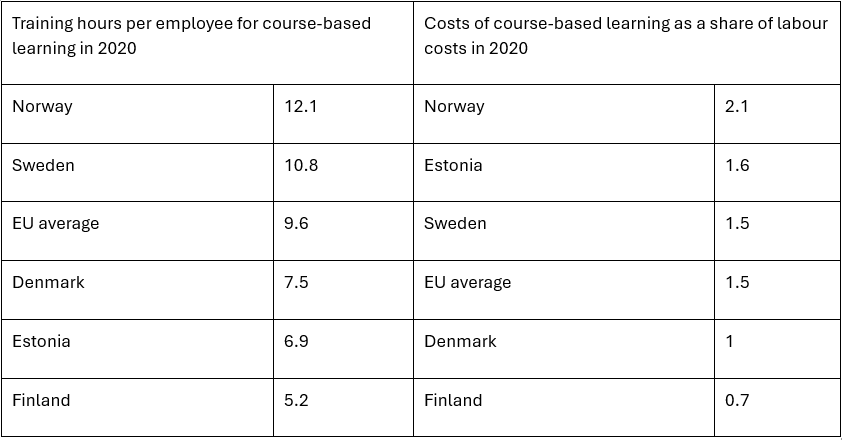The disappearance of professions and the emergence of new ones is part of the natural evolution of a labour market. This is why the skills of adults need to be nurtured throughout he life. In a Nordic comparison, Finland ranks poorly on many metrics of adult learning. How does this affect the competitiveness of the Finnish capital region?
To develop the labour market in the capital region, we need to ensure the availability of a skilled workforce. Technological developments and the green transition, for example, offer new opportunities for businesses, but they also change the skills requirements for jobs.
History has shown that the disappearance of occupations and the emergence of new ones is part of this cycle of development. It is therefore essential that the working-age population develops and updates their skills in a variety of ways throughout the working life.
Lifelong learning delivers broad societal benefits
At The Ami Foundation, we see lifelong learning as more than just a response to the changing demands of working life. Lifelong learning enriches both work and leisure time and generates broad societal benefits.
Learning and self-development is not limited to formal education and training, as learning takes place continuously through work, hobbies and other leisure activities. Self-education has an intrinsic value.
In 2024, Finland will celebrate the Year of Sivistys, which reminds us of the importance of learning, education and culture as part of everyone’s everyday life.
Overview of the Adult Education Survey
We have statistically examined the state of adult education and training in Finland and the Helsinki Metropolitan Area. The Adult Education Survey data for the Finnish capital region have been obtained from Statistics Finland, and corresponding data from the statistical authorities in Sweden and Norway.
In this comparison, we have also included statistics on staff training in companies, which provide a comprehensive picture of the training within the working age population. Liberal adult education plays an important role in lifelong learning in Finland, and we return to this topic in more detail in the next blog post.
The Adult Education Survey is a large-scale interview survey of the adult population’s participation in education and learning. It provides internationally comparable data as part of the European Adult Education Survey. More information on the survey is available on the Finnish National Agency for Education’s website.
The data we have analysed are for the population aged 18–64, including all education and training that respondents report having attended for work or occupational reasons.
The 2022 survey looked at participation in adult education and training for the period 1 August 2021 – 31 July 2022.
Adult education and training in the capital region’s largest cities have taken a downward turn: participation rates in adult education and training related to work or occupation have fallen between 2017 and 2022.
The duration of training, measured in hours of training per person, has also decreased significantly. This decline may be partly explained by the fact that the period under review still coincided with the period of the COVID-19 pandemic restrictions.
Adult vocational education and training – comparing with Sweden and Norway
In Sweden, especially in the Stockholm region, the population’s participation in adult education and training has increased between 2017 and 2022. Swedes have become more actively involved in work and occupational adult education and training, and the number of hours of training has increased in parallel.
The corresponding figures for the Finnish capital region have fallen over the same period.
In Norway, in the Oslo-Viken area, 2017 data are not comparable due to anonymisation. Comparable figures for 2022 show that participation rates and training hours in work or occupation-related training have been significantly higher in the Oslo-Viken area than in the Finnish capital region.
We have compiled data on the participation in adult education and training related to work or occupation, and the duration of adult education and training related to work or occupation, between 2017 and 2022 for different capital regions. This analysis focuses on the labour force aged 18–64.
Click here to see the statistics (pdf opens in a new window).
Staff training in the light of statistics
Staff training in EU-based companies can be examined through the Continuing Vocational Training Survey (CVTS), which is conducted every five years.
The latest survey from 2020 focuses on the development of staff skills, the number of people who have taken courses, course content and providers, and the detailed cost of training.
On Statistics Finland’s website, Senior Statistician Tarja Seppänen provides international comparative data on the statistics, which we make use of in this analysis.
Finland ranks poorly in The Nordics (Pohjola in Finnish), comprising the Nordic Countries and Estonia (Tallinn). Between 2015 and 2020, the share of workers undertaking course-based learning has fallen across the EU, partly due to the COVID-19 pandemic. However, the decline in Finland has been the steepest in the whole of the EU.
According to the CVTS survey, Finland ranks at the bottom of the EU in terms of training hours per employee for course-based learning, while Norway and Sweden are among the best. The share of course-based training costs of overall labour costs also reveals Finland’s poor ranking in contrast to Norway’s excellent performance.

The impact of the CVTS survey
The results of the CVTS survey reveal that businesses in Norway are investing more in course-based staff training than those in Finland.
This raises a question: Do Finnish companies have fewer resources for developing competences than those in other Nordic countries, or do Finnish companies develop competences in other ways that are not measured by the CVTS?
If it is not the latter, it is worrying that skills development in Finland is lagging behind the rest of The Nordics. It will be important to monitor the development of both adult education research and the development of staff training in companies in the future.
The impact of the COVID-19 pandemic on education is obvious, but the statistics also raise other concerns. According to our understanding, the proportion of population with higher level education has started to decline in the Finnish capital region. At the same time, the proportion of population with, statistically, primary or unknown level of education is increasing.
This trend is the opposite to the rest of The Nordics.
How do declining educational attainment and low participation in adult learning affect the competitiveness of our capital region? We know that, in Finland people over-55s face more employment challenges compared with other Nordic countries.
Could this be due to lower investment in skills development – including adult vocational education and staff training – throughout working lives? Does this translate into difficulties in finding employment at the tail end of a career?
- COVID hit course-based learning in companies – indicators in Finland clearly lag behind peer countries[
- Finnish National Agency for Education: Adult Education Survey
- Year of Sivistys
- The Service Centre for Continuous Learning and Employment JOTPA
- Survey: what people of working age think about continuous learning in 2023
